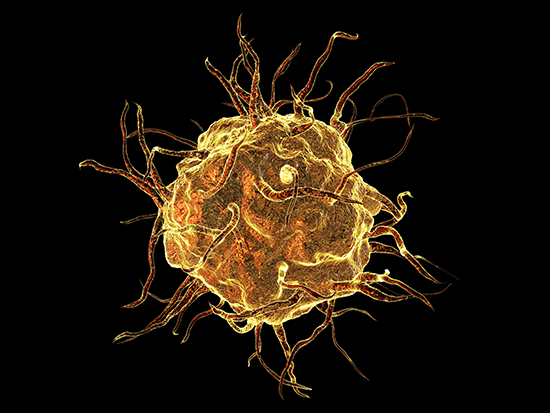A form of cell communication called hedgehog signaling is vital for embryonic development in mammals. But aberrantly activated hedgehog signaling in multiple cancer types — including breast cancer — promotes tumor invasion, its spread to other organs and multi-drug resistance.
Two years ago, Lalita Shevde, Ph.D., and colleagues showed that hedgehog signaling plays a significant role in altering the immune components of the tumor microenvironment. Now they report how aberrant hedgehog signaling for tumor-associated macrophages — the immune cells that should be pro-inflammatory guardians against tumor growth — instead transforms them to nonaggressive, immunosuppressive macrophages, called M2 macrophages.
This signaling by the tumor microenvironment suggests that use of existing, clinically approved hedgehog-signaling inhibitors may diminish the tumor-promoting properties of tumor-associated M2 macrophages within the tumor microenvironment. Elevated infiltration of immunosuppressive, alternatively polarized M2 macrophages is associated with poor prognosis in cancer patients.
“The allure of targeting hedgehog signaling stems from the availability of several U.S. Food and Drug Administration-approved inhibitors already in use in the clinic, making it applicable to different tumor types,” said Shevde, a University of Alabama at Birmingham professor of pathology, who published her study in the journal Cancer Research. “Our work supports the possibility that hedgehog blockade is multi-dimensional in its effect on recalibrating the metabolism and, consequently, the functions of immunosuppressive macrophages.
“Thus, inhibition of hedgehog signaling could present with the dual benefit of directly targeting tumor cells and re-configuring the tumor immune microenvironment to an immune-activated state.”
M1 and M2 macrophages have distinct metabolic circuitries that contribute to their survival and different functions in the immune response. M1 macrophages have a metabolism that creates energy through glycolysis, which is sufficient for their tumor-eradicating functions, while M2 macrophages use oxidative phosphorylation, which is a much more efficient way to produce the energy needed for their tumor-promoting functions.
Using two mouse models of mammary tumors and treating them with the hedgehog inhibitor Vismodegib, Shevde and colleagues saw a remarkable shift in the tumor-infiltrating macrophages. The inhibitor significantly altered macrophage metabolism, especially reducing the flow through the uridine diphosphate N-acetylglucosamine biosynthetic pathway.
 Lalita Shevde, Ph.D.
Lalita Shevde, Ph.D.
(Photography: Nik Layman)This, in turn, had a downstream effect on the transcription factor STAT6, decreasing its O-linked-N-acetylglucosaminylation, or O-GlcNAc, modification making it more active, which led to increased expression of genes Arg1 and Cd206 that are crucial for the immune-suppressive state of M2 macrophages. Upregulated STAT6 activity also led to increased expression of genes that shift the metabolism to fatty acid oxidation for the metabolically demanding M2 macrophages.
However, when the hedgehog inhibitor led to reduced O-GlcNAc-modification of STAT6, the macrophage metabolism and bioenergetics shifted from oxidative phosphorylation and fatty acid oxidation to glycolysis. Mitochondria — the powerhouses of the cell — changed from the fused mitochondria typical of cells utilizing fatty acid oxidation, to fragmented mitochondria.
“These hedgehog-inhibited macrophages are reminiscent of inflammatory M1 macrophages, phenotypically characterized by fragmented mitochondria,” Shevde said. “This is the first time that hedgehog activity has been shown to regulate metabolic and bioenergetic programming of tumor-associated macrophages. Further, our work provides evidence for modulating hedgehog activity, and consequently macrophage metabolism, to sculpt the plasticity of macrophages.”
Hedgehog signaling involves the so-called hedgehog proteins that bind to cells and initiate a signal inside the cell. This signaling pathway guides development of all bilateral animals during embryogenesis. The first two hedgehog genes were discovered from fruit fly mutations that made the fruit fly larvae look stubby and spiky like a hedgehog, so they were named after species of hedgehogs: Desert hedgehog and Indian hedgehog. The third mutation made the fly look like the video game character Sonic the Hedgehog, so Sonic Hedgehog became the name of that gene.
Co-authors with Shevde in the study, “Hedgehog signaling regulates metabolism and polarization of mammary tumor associated macrophages,” are Dominique C. Hinshaw, Tshering Lama-Sherpa, Brandon Metge, Sarah C. Kammerud, Gloria A. Benavides, Atul Kumar, Heba Allah Alsheikh, Mateus Mota, Scott W. Ballinger, Selvarangan Ponnazhagan, Victor Darley-Usmar and Rajeev S. Samant, UAB Department of Pathology; Ann Hanna, Vanderbilt Center for Immunobiology, Vanderbilt University School of Medicine, Nashville, Tennessee; Dongquan Chen, Division of Preventive Medicine, UAB Department of Medicine; and Jeffrey C. Rathmell, Department of Pathology, Microbiology and Immunology, Vanderbilt University Medical Center, Nashville, Tennessee.
Support came from United States Department of Defense grants W81XWH-14-1-0516, W81XWH-18-1-0036 and W81XWH-10-1-0755; National Institutes of Health grants CA169202 and CA194048; O’Neal Invests; the Breast Cancer Research Foundation of Alabama; and United States Department of Veterans Affairs grant BXAl3374.
Shevde is a senior scientist in the O’Neal Comprehensive Cancer Center at UAB.
